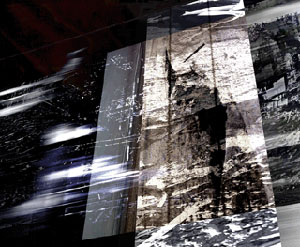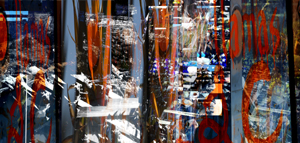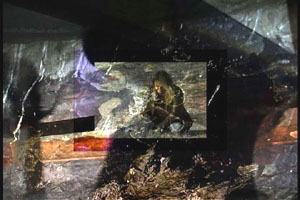The Ground Is Still Moving
John Haberin New York City
Christina McPhee's Digital Landscapes
Take it from Christina McPhee: "It just happened. The ground is still moving."
Just the facts: it sounds like classic detective fiction, but where is the body? With McPhee's digital prints and video, the data are real, and so is the threat. Her intervention into California's seismic landscape becomes at once a science project, a detective story, a map of the world, and an elusive self-portrait. She tracks a series of natural disasters, incorporating real-time data along with a very human narrative.  She also raises questions about the stability of either—and they offer clues as well to her abstract paintings and drawings, which remain central to her work.
She also raises questions about the stability of either—and they offer clues as well to her abstract paintings and drawings, which remain central to her work.
Just the facts
Where, then, is the body? The Salton Sea sits beside a shallow lake located right on the San Andreas fault, where efforts to provide irrigation unleashed a catastrophe—a flow of water and soil from the Colorado River. McPhee's La Conchita Mon Amour documents the aftermath of debris flows that devastated a small California coastal town and is visible to this day. Built on a mudslide, La Conchita has had its share of disasters, as in 2005, when rains washed out the roads and ten people died.
Another series, The Carrizo-Parkfield Diaries, refers to the Carrizo plain in north-central California. Straddling the fault zone, it has become a national monument more for its geology than for its scenic beauty or still-recovering ecosystem. The narrow mountains to either side, the Caliente and Tremblor Ranges, could well stand for California's twin terrors of drought and disaster. Their very names invite one to feel the heat and the trembling. Parkfield, roughly halfway between Monterey and Bakersfield, could in turn stand for the state's notorious transience and anonymity.
For three million years the fault has been slipping about two inches a year. One does not often feel its tremors, perhaps ten thousand in a single year, no more than one can feel one's fingernails grow at roughly the same pace. Yet from its shocks, great and small, McPhee purports to visualize an active landscape.
Each series translates data from the U.S. Geological Survey into shifting images. She also relies on her own photos made on the spot, using a medium-format or digital camera. She takes her visual vocabulary, though, from her earlier abstract paintings and past new media:
I incorporate layers of field observation within a dream-like sequence of abstract images, where passages of linear structures and shadowed mass allude to ruins and debris in the wake of recent tremors. By means of architectural scale, at 72 to 92 inches, each print is like a page torn from a cinematic notebook—film stills from an event-scene that has almost materialized, laced with traces from geomorphologic maps. Flash animations trigger from a selective crashing of online live data against archived data from the recent 6.0 quake at Parkfield.
For comparison, the damaging 1994 Northridge quake had a magnitude of 6.7. Reconstructions of the 1906 San Francisco earthquake place it anywhere from 7.7 to 8.3. The largest magnitude ever recorded, in Chile in 1960, reached 9.5. Anything greater than 6.0 officially ranks as strong.
McPhee mimes another kind of disturbed flow as well—of observation in real time. She returned to her sites at one-month intervals, with their crushed cars, vacant yards, improvised gardens, and battered homes. When she calls the community's gestures a "vernacular shrine to the dead," she could be speaking of her work.
Black mon amour
Like Catherine Opie, McPhee has her American Cities. She has photographed San Francisco streets, too, and documented her own travels through California. She speaks of "a screen so vast it becomes a night city." No one, though, would mistake her work for street photography. One may have trouble classifying it as photography at all.
The digital prints do what photojournalism or even glazes on canvas cannot. They convey detail and color with exceptional clarity, and they layer memory upon memory. They appear not glossy or subdued, but clear, unreflective, and pitch dark, shot through with color. They flood gallery walls with deep color and sheer information. I had never seen black so transparent to the light.
 For all their size, one cannot mistake them for the fashionably large, static photographs of Jeff Wall or Andreas Gursky. Rather, like Barbara Ess or Barbara Crane, they contain fragmentary images on a range of scale, from murals to contact prints. At times, prints cover the gallery as itself a landscape, their horizontal format defining a horizon. Vertical prints adopt the format of her panel paintings, like doors leading from the gallery to riskier territory. They oblige one to linger over a shattered landscape.
For all their size, one cannot mistake them for the fashionably large, static photographs of Jeff Wall or Andreas Gursky. Rather, like Barbara Ess or Barbara Crane, they contain fragmentary images on a range of scale, from murals to contact prints. At times, prints cover the gallery as itself a landscape, their horizontal format defining a horizon. Vertical prints adopt the format of her panel paintings, like doors leading from the gallery to riskier territory. They oblige one to linger over a shattered landscape.
They also place that landscape in the brutal context of capitalist exploitation. Blacks become marks of human erasure of the lands, and neon colors become signs of ravaging. A juxtaposition of images corresponds to the displacement of lives and property. Their overlays correspond to physical barriers within the work, in fences and barbed wire. The printing against broad bands of white above and below adds another fatal distance. The sheer beauty only makes matters worse.
The construction of the prints suggests a breakdown in time and succession—what Gilles Deleuze in describing New Wave film calls "beyond the movement-image." The very title La Conchita Mon Amour puns on Hiroshima Mon Amour, the film by Alain Renais. The prints make use of both overlay and juxtaposition, sometimes of repeated images or close variations, like contact sheets or a film strip. Blackness further labels the prints as a representation of the process and materials behind their making.
The overlaid images can look at one glance like landscapes, at another like personal histories. What looks at first, too, like sheer blackness hides traces of intense color. She allows herself explicit naturalism, but also the appearance of rubble. Imagine a nonsite by Robert Smithson pouring its contents off the wall.
Between abstraction and new media
With their visual and temporal complexity, the prints work as abstraction or as new media as well. Not surprisingly, McPhee has a continuing interest in both. The prints translate easily into abstraction, where black and color function as themselves. They also translate into her video, where the fragmentation builds into unspoken narratives. All three media linger over absences, from empty lots to traces of the artist's hand. Take a moment, then, to consider them together.
I first encountered McPhee as a painter. Over time, her abstractions have grown more painterly without losing a basis in drawing. Her interlacing curves have contemporary parallels in Julie Mehretu, Sue Williams, Joanne Greenbaum, Cecily Brown and Brown in retrospective at the Met, or Sara Sze, but with a greater investment in landscape. They have strong elements of gestural abstraction and calligraphy, but without the nostalgia of too much abstraction these days. They also leave the tranquility of Chinese art largely behind. 
In two tall paintings from after 2000, color comes in bursts of layered brushwork. It can explode from within, as if through a thick atmosphere, or move downward like an implosion. One painting layers white over red, where red determines the palette while white asserts surface and volume. The other's dark purples give way at bottom to a tunnel of light. A vertical of craquelure is itself both drawing and volume. The heavy support for the two paintings, wood that rests on the floor and leans against the wall, adds to the sense of color as mass.
The connection between prints and video is just as important. Does the blackness of her prints evoke a film strip, with a detective holding the evidence up the light? She has appeared in a group show called "Persona-Personae." And looking at the sites, one starts to wonder where all the people went.
In past video, she has presented a natural disaster as a crime scene. One can hear unseen presences, in muffled voices and the harsh sound of traffic along the Pacific Coast Highway. McPhee has spoken of the allure of trauma, and at least some of the presences may be hers.
In her experiments with interactive software, the viewer can stretch or compress sound and images with a mouseover. On a Southwestern highway, the artist lies face up with her head and upper torso on camera, like Cindy Sherman without the disguise or disgust. As the camera circles her head, a cryptic narration unfolds, speaking of loss in relationships and in art. Are they hers or the viewer's? She is not saying.
A quake as criminal act
In one installation, an abstract drawing comes between each pair of prints, and a video plays along with them to complete the story. The media interrupt one another and respond to one another. They could stand for successive moments in crossing an actual landscape. The video ticks off a further collage of photographs, like a metronome. They play out like a secret history.
If this again sounds like a detective story, a related video and performance work gives an earthquake the appearance of a criminal act. Salt opens with real quake damage, in which two women lost their lives. Once more, the damage centered on the Carrizo plain. Yet it also adopts the conventions of crime-scene investigation.
 The scene moves among empty lots, a figure bent in search of evidence, and heads poised as if for a press conference. As the body in question turns up, the montage of artificial lights takes on ghostly echoes of film noir, underscored by chilly, repetitive piano music.
The scene moves among empty lots, a figure bent in search of evidence, and heads poised as if for a press conference. As the body in question turns up, the montage of artificial lights takes on ghostly echoes of film noir, underscored by chilly, repetitive piano music.
Of course, the body in question is a woman's. It also serves as a transition from the earthquake's daylight robbery to the nighttime explosions of art. Accompanying text refers to "traces of her presence in fleeting gestures and in spaces that extend beyond the browser, as if there is a screen so vast it becomes a night city."
Here physical tremors serve as metaphors for psychic shocks—what McPhee calls "psychic architecture." A Californian, she finds beauty in the landscape's desert grasses, "reaching toward heaven," perhaps even after an aftershock and as the promise of recovery.
Near the end, strands of police tape promise just that return to normality. Yet its authority also recalls the forces that can reduce a woman to an object of desire. And then the video loops and starts again, like traumatic memory. Salt traps one in the present the moment one looks back.
Digital authority
Can digital art really reproduce landscape? Does it serve as documentation or a diary of terror? Do the data at its heart confer authority, or do they prove only the potential for the virtual to displace the real? Do the data even exist? What if McPhee is making all this up, and what if images spin out on screen according to her whim or at random? Would that make her less reliable—or closer still to life?
Experiencing her digital work involves weighing these claims. Lev Manovich identifies the syntax of digital art with the computer's file structure, much as Noam Chomsky sees innate syntactic structures in human language, but a connection between the finished image and the original data does not flow naturally. Recall her description of "selective crashing of online live data against archived data." The word crashing slips between the earth's plates and components of the artist's thought processes. It encompasses the collisions of online images with the viewer's perceptual field. It points to real dangers from greed, natural hazards, and sheer incompetence.
Digital art still has a hard time shaking the illusion of naturalism. For one thing, it adds the authority of science to the traditional aura surrounding art. Old habits die hard, especially if the U.S. Geological Service and a pack of computer geeks come to their rescue. Second, digital art has a fascination with "virtual reality" and computer simulation. Even when sophisticated users acknowledge the virtual, they may believe that all reality is virtual anyway, one more episode of The Matrix.
Data structures perpetuate another myth about art, too—the myth of the trace. Many people think of representation as the tracing of the real world on canvas, perhaps mediated by a camera obscura, a lens, or a mirror.  A philosopher, Barbara Savedoff, points to a near-universal belief in photography, based on its arising as an unmediated trace of light. A database makes much the same claim to raw data.
A philosopher, Barbara Savedoff, points to a near-universal belief in photography, based on its arising as an unmediated trace of light. A database makes much the same claim to raw data.
The puzzle of defining new media contributes to these habits. A formalist may want digital art to exemplify its nature as a medium—a medium that relies on information. A traditionalist may place digital art in context of art movements, including performance art, sound art, and interactive art. The digital community may see new media instead as community structures. Some digital works also revel in their connection to film or painting, as does McPhee.
Every trace attests to an absence, the presence that left its impression. Database-driven art, too, attests to loss. Like documentary photography, it can numb by sheer repetition, now at a lightning pace. Like painting, it promises a higher reality, but now in virtual space.
McPhee's digital landscapes challenge the illusion. One can see them as a layering of memories or as felt disjunctions between the layers. They stick closely to ecological damage, while evoking personal damage as well. Art has a long and sordid history of identifying woman and landscape, as in the work of Ana Mendieta, but the male gaze can overlook something: both have suffered damage.

Christina McPhee ran at Cælum through February 26, 2000, at Transport Gallery in Los Angeles through April 16, 2005, at Rx gallery in San Francisco through June 8, 2005, and at Sara Tecchia, through November 22, 2006. Her painting and multimedia are also featured in Whitney Artport for March 2005, in her talk that month at the Parsons Design Lab, and online. "Persona-Personae" ran at Sara Tecchia through February 25, 2006. An interview quoted here, "1000 Days of Theory: Slipstreaming the Cyborg," appeared May 6, 2005, on ctheory.net. Portions of this review first appeared in Artillery magazine. A related review asks whether digital art can lie.




